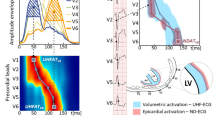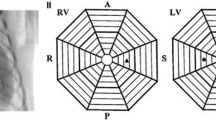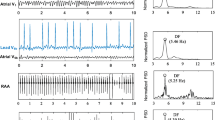Abstract
Purpose
We hypothesized that in patients with left ventricular dysfunction undergoing implant of a biventricular ICD, the local dominant frequency during early induced ventricular fibrillation would be higher at an epicardial left ventricular position compared to an endocardial right ventricular position.
Methods
Patients undergoing implant of a biventricular ICD were studied. During ventricular fibrillation induction, bipolar electrograms were recorded from leads at an epicardial left ventricular position and an endocardial right ventricular position. Overlapping 2-s fast Fourier transforms were obtained for 6 s of ventricular fibrillation. The dominant frequency and organizational index were compared.
Results
Thirty-four patients (20 men, age 64 ± 11 years) underwent 57 inductions of ventricular fibrillation. Eighteen patients had non-ischemic dilated cardiomyopathy and 16 had ischemic dilated cardiomyopathy. The dominant frequency was higher at a lateral epicardial left ventricular position than an apical endocardial right ventricular position in 18 patients with non-ischemic dilated cardiomyopathy (LV epicardial 5.34 ± 0.37 Hz, RV endocardial 5.09 ± 0.41 Hz, p < 0.001), but not in 16 patients with ischemic dilated cardiomyopathy (LV epicardial 4.99 ± 0.57 Hz, RV epicardial 4.87 ± 0.65 Hz, p = 0.094).
Conclusions
In patients with non-ischemic dilated cardiomyopathy, there is a dominant frequency gradient during early ventricular fibrillation induced at ICD testing from the lateral left ventricular epicardium to the apical right ventricular endocardium.




Similar content being viewed by others
References
Choi, B. R., Nho, W., Liu, T., & Salama, G. (2002). Lifespan of ventricular fibrillation frequencies. Circulation Research, 91, 339–345.
Valderrabano, M., Lee, M. H., Ohara, T., Lai, A. C., Lin, S.-F., Fishbein, M. C., et al. (2001). Dynamics of intramural and transmural reentry during ventricular fibrillation in isolated swine ventricles. Circulation Research, 88, 839–848.
Valderrabano, M., Yang, J., Omichi, C., Kil, J., Lamp, S. T., Qu, Z., et al. (2002). Frequency analysis of ventricular fibrillation in swine ventricles. Circulation Research, 90, 213–222.
Zaitsev, A. V., Berenfeld, O., Mironov, S. F., Jalife, J., & Pertsov, A. M. (2000). Distribution of excitation frequencies on the epicardial and endocardial surfaces of fibrillating ventricular wall of the sheep heart. Circulation Research, 90, 408–417.
Chen, J., Mandapati, R., Berenfeld, O., Skanes, A. C., & Jalife, J. (2000). High frequency periodic sources underlie ventricular fibrillation in the isolated rabbit heart. Circulation Research, 86, 86–93.
Nash, M. P., Mourad, A., Clayton, R. H., Sutton, P. M., Bradley, C. P., Hayward, M., et al. (2006). Evidence for multiple mechanisms in human ventricular fibrillation. Circulation, 114, 536–542.
Nanthakumar, K., Walcott, G. P., Melnick, S., Rogers, J. M., Kay, M. W., Smith, W. M., et al. (2004). Epicardial organization of human ventricular fibrillation. Heart Rhythm, 1, 14–23.
Walcott, G. P., Kay, G. N., Plumb, V. J., Smith, W. M., Rogers, J. M., Epstein, A. E., et al. (2002). Endocardial wave front organization during ventricular fibrillation in humans. Journal of the American College of Cardiology, 39, 109–115.
Lazar, S., Dixit, S., Marchlinski, F. E., Callans, D. J., & Gerstenfeld, E. P. (2004). Presence of left to right atrial frequency gradient in paroxysmal but not persistent atrial fibrillation in humans. Circulation, 110, 3181–3186.
Ng, J., Kadish, A. H., & Goldberger, J. J. (2007). Technical considerations for dominant frequency analysis. Journal of Cardiovascular Electrophysiology, 18, 757–764.
Ng, J., Kadish, A. H., & Goldberger, J. J. (2006). Effect of electrogram characteristics on the relationship of dominanat frequency to atrial activation rate in atrial fibrillation. Heart Rhythm, 3, 1295–1305.
Everett, T. H., Wilson, E. E., & Olgin, J. E. (2007). Effects of atrial fibrillation substrate and spatiotemporal organization on atrial defibrillation thresholds. Heart Rhythm, 4, 1048–1056.
Opthof, T., Ramdat Misier, A. R., Coronel, R., Vermeulen, J. T., Verberne, H. J., Frank, R. G. J., et al. (1991). Dispersion of refractoriness in canine ventricular myocardium. Circulation Research, 68, 1204–1215.
Newton, J., Smith, W. M., & Ideker, R. E. (2004). Estimated global transmural distribution of activation rate and conduction block during porcine and canine ventricular fibrillation. Circulation Research, 94, 836–842.
Mansour, M., Mandapati, R., Berenfeld, O., Chen, J., Samie, F. H., & Jalife, J. (2001). Left-to-right gradient of atrial frequencies during acute atrial fibrillation in the isolated sheep heart. Circulation, 103, 2631–2636.
Hsia, H. H., & Marchlinski, F. E. (2002). Characterization of the electroanatomical substrate for monomorphic ventricular tachycardia in patients with nonischemic cardiomyopathy. PACE, 25, 1114–1127.
Hsia, H. H., & Marchlinski, F. E. (2002). Electrophysiologic studies in patients with dilated cardiomyopathy. Cardiac Electrophysiology Review, 6, 472–481.
Author information
Authors and Affiliations
Corresponding author
Rights and permissions
About this article
Cite this article
Torres, J.L., Shah, B.K., Greenberg, R.M. et al. A left ventricular epicardial to right ventricular endocardial dominant frequency gradient exists in human ventricular fibrillation. J Interv Card Electrophysiol 29, 11–16 (2010). https://doi.org/10.1007/s10840-010-9488-2
Received:
Accepted:
Published:
Issue Date:
DOI: https://doi.org/10.1007/s10840-010-9488-2




